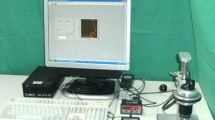Abstract
Objectives
This paper aims to evaluate in vitro the mechanical and microstructural properties of internal fixation systems used in oral and maxillofacial surgeries.
Materials and methods
Four brands of internal fixation systems (screws and 4-hole straight plates) were selected and assigned to four groups: G1 Leibinger®, G2 Tóride®, G3 Engimplan®, and G4 Medartis®. The systems were submitted to Vickers hardness testing, metallographic and interstitial elements chemical composition analyses. Data were submitted to ANOVA and Tukey’s test for statistical analysis.
Results
Plates in groups 1, 2, and 3 showed similar microstructure and mechanical properties, different from those in G4 revealing larger grains. In all groups, the screws showed similar microstructure, with uniform arrangement and size of grains; the screws showed higher hardness values than those observed for the plates.
Conclusions
The results indicate that all materials tested are adequate for use in oral maxillofacial surgeries.




Similar content being viewed by others
References
Ariyan GF (1984) Facial fractures: Hippocratic management. Head & Neck Surgery 6:1007–1013
Fonseca RJ, Frost H, Hersh E, Levin LM (2000) Oral and maxillofacial surgery, 3ªEd, vol 1, cap 18. Publisher Saunders, St Louis Missouri, p 481–522
Greenberg AM, Prein J (2002) Craniomaxillofacial reconstructive and corrective bone surgery: principles of internal fixation using the AO/ASIF technique. Springer© Springer-Verlag, New York, chapter 12. ISBN 0-387-94686-1
Katakura A, Shibahara T, Noma H, Yoshinari M (2004) Material analysis of AO plate fracture cases. J Oral Maxillofac Surg 62:348–352
Eliaz N (2012) Degradation of implant materials. Springer Science Business Media, New York, p 29
Trivellato AE, Mazzonetto R, Passeri LA, Consani S (2000) Estudo químico, macroscópico e da resistência à flexão de placas e parafusos de titânio usados na fixação interna rígida. Pesqui Odontol Bras 14(4):392–398
ASTM E3-95: Standard Practice for Preparation of Metallographic Specimens. http://compass.astm.org/Standards/HISTORICAL/E3-95.htm. Accessed 9 Nov 2015
American Society for Testing Materials, Philadelfia. E384-11e1; Standard test method for Knoop and Vickers hardness of materials. 2011-http://www.astm.org/Standards/E384.htm
ASTM F67: Standard Specification for Unalloyed Titanium, for Surgical Implant Applications. http://www.astm.org/cgi-bin/resolver.cgi?F67-13. Accessed 9 Nov 2015
ASTM F136: Standard Specification for Wrought Titanium-6Aluminum-4Vanadium ELI (Extra Low Interstitial) Alloy for Surgical Implant Applications (UNS R56401). http://www.astm.org/cgi-bin/resolver.cgi?F136-13. Accessed 9 Nov 2015
Ray NJ (1986) Aspects of the metallography of some pre-formed root canal posts and dentine pins. J Dent 14:218–222
ASTM F543-13: Standard Specification and Test Methods for Metallic Medical Bone Screws. http://www.astm.org/cgi-bin/resolver.cgi?F543-13e1. Accessed 9 Nov 2015
ASTM F382 – 99(2008)e1: Standard Specification and Test Method for Metallic Bone Plates. http://compass.astm.org/Standards/HISTORICAL/F382-99R08E1.htm. Accessed 9 Nov 2015
Bresciani-Filho E, Silva IB, Batalha GF, Button ST. Conformação plástica dos metais. Campinas-SP: Editora da Unicamp, 6ª edição (1ª edição digital), 2011. http://www.fem.unicamp.br/~sergio1/CONFORMACAOPLASTICADOSMETAIS.pdf. Accessed 9 Nov 2015
Leyens C, Peters M (2003) Titanium and titanium alloys. In: Fundamentals and applications. WILEY-VCH Verlag GmbH & Co. KGaA, Weinheim. ISBN 3-527-30534-3
Wright TM, Maher SA (2007) Biomaterials. In: Einhorn T, O’Keefe R, Buckwalter J (eds) Orthopaedic basic science foundations of clinical practice, 3rd edn. American Academy of Orthopedic Surgeons, Rosemont, IL, pp 65–75
Bundy KJ (1994) Corrosion and other electrochemical aspects of biomaterials. Crit Rev Biomed Eng 22:139–251
Hayes JS, Richards RS (2010) The use of titanium and stainless steel in fracture fixation. Expert Rev Med Devices 7(6):843–853
Merritt K, Brown SA (1995) Release of hexavalent chromium from corrosion of stainless steel and cobalt-chromium alloys. J Biomed Mater Res 29:627–633
Singh R, Dahotre NB (2007) Corrosion degradation and prevention by surface modification of biometallic materials. J Mater Sci Mater Med 18:725–751
Acevedo D, Loy BN, Lee B, Omid R, Itamura J (2013) Mixing implants of differing metallic composition in the treatment of upper-extremity fractures. Orthopedics 36(9):e1175–9. doi:10.3928/01477447-20130821-21
Ciuccio RL, Luiz NE, Jacomini-Filho A, Alvarado PP (2010) Testing of galvanic corrosion of titanium plates and screws used in rigid internal fixation. Innov Implant J, Biomater Esthet (Online) 5(3):19–22, ISSN 1984–5960
Keel JB, Kuster MS (2004) Massive wear of an incompatible metal-on-metal articulation in total hip arthroplasty. J Arthroplasty 19:638
Fazel-Rezai R (2011) Biomedical engineering—from theory to applications. Chapter 17. Metals for biomedical applications. Copyright © InTech, Rijeka. ISBN 978-953-307-637-9
Iamashita HY, Pereira VA, Monnazzi MS, Gabrielli MFR, Vaz LG, Passeri, LA. In vitro biomechanical evaluation of sagittal split osteotomy fixation with a specifically designed miniplate, Int J Oral Maxillofac Surg (2012), http://dx.doi.org/10.1016/j.ijom.2012.07.008
Haug RH, Serafin BL (2008) Mandibular angle fractures: a clinical and biomechanical comparison—the works of Ellis and Haug. Craniomaxillofac Trauma Reconstr 1(1):31–38. doi:10.1055/s-0028-1098961
Haug RH, Fattahi TT, Goltz M (2001) A biomechanical evaluation of mandibular angle fracture plating techniques. J Oral Maxillofac Surg 59(10):1199–1210
Martola M, Lindqvist C, Hänninen H, Al-Sukhun J. Fracture of titanium plates used for mandibular reconstruction following ablative tumor surgery. Journal of Biomedical Materials Research Part B: Applied Biomaterials. DOI 10.1002/jbmb. 2006
Karl-Winnacker-Institut. Minimization of the oxygen embrittlement of Ti-Alloys. High Temperature Materials. DECHEMA - Forschungsinstitut. 2011. [acesso em 2012 Agost 03] http://kwi.dechema.de/kwi/en/englishkwi.html
Woodford DA. Gas phase embrittlement and time dependent cracking of nickel based superalloys. Energy Materials 2006;1(1), 59–79. doi: 10.1179/174892306X99679
Hayes RW. Oxygen embrittlement and time-dependent grain-boundary cracking of ALLVAC 718PLUS. Volume 39A, November 2008. The Minerals, Metals & Materials Society and ASM International 2008. DOI: 10.1007/s11661-008-9564-8
Floreen S, Raj R (1983) Flow and fracture at elevated temperature. ASM, Warrendale, PA, pp 383–404
Acknowledgments
The authors wish to thank Fundação de Amparo à Pesquisa do Estado de São Paulo (FAPESP) and Prof. Dr. Rubens Caram Jr. and to FEM/DEM/LABMET—Unicamp for your important support in conducting and analyzing the data.
Author information
Authors and Affiliations
Corresponding author
Ethics declarations
Conflict of interest
The authors declare that they have no conflict of interests.
Rights and permissions
About this article
Cite this article
Mendes, M.B.M., de Medeiros, R.C., Lauria, A. et al. Mechanical and microstructural properties of fixation systems used in oral and maxillofacial surgery. Oral Maxillofac Surg 20, 85–90 (2016). https://doi.org/10.1007/s10006-015-0532-3
Received:
Accepted:
Published:
Issue Date:
DOI: https://doi.org/10.1007/s10006-015-0532-3




